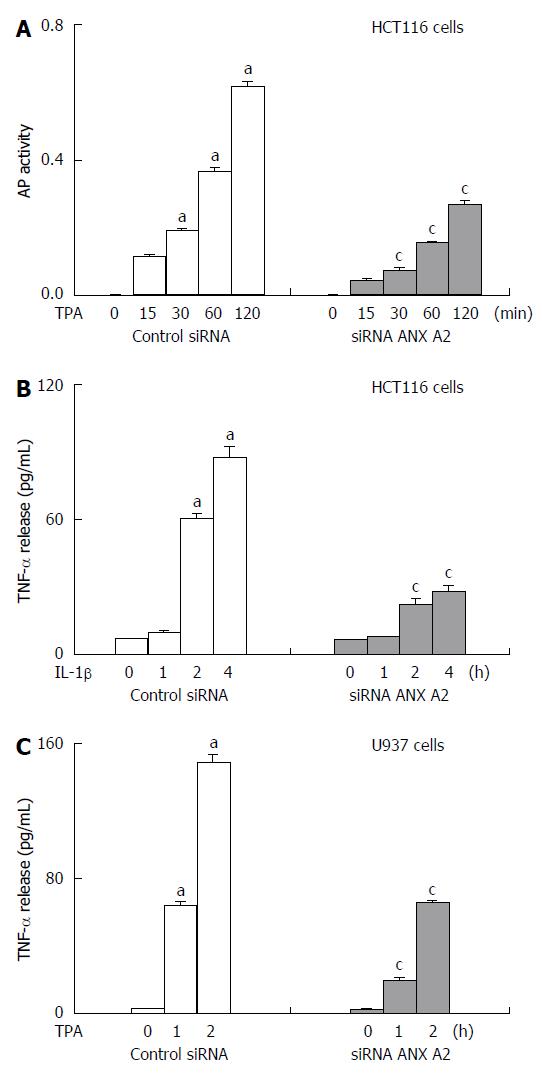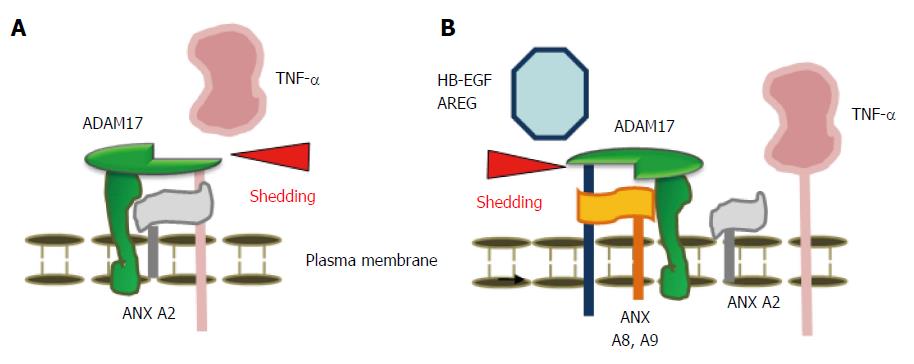Copyright
©The Author(s) 2015.
World J Gastroenterol. Aug 7, 2015; 21(29): 8776-8786
Published online Aug 7, 2015. doi: 10.3748/wjg.v21.i29.8776
Published online Aug 7, 2015. doi: 10.3748/wjg.v21.i29.8776
Figure 1 Involvement of annexin A2 in tumor necrosis factor-α ectodomain shedding and release.
Quoted and adapted from Ford et al[14]. A: Quantitative analysis of TNF-α shedding during TPA stimulation of HCT116 cells overexpressing AP-tagged proTNF-α and inhibitory effects of ANX A2 siRNA on TNF-α shedding. aP < 0.05 vs control for the stimulatory effect, and cP < 0.05 vs control for the inhibitory effect; B: Inhibitory effect of ANX A2 siRNA on IL-1β-induced TNF-α release from HCT116 cells. The concentration of TNF-α released into the conditioned medium was measured using ELISA. aP < 0.05 vs control for the stimulatory effect, and cP < 0.05 vs control for the inhibitory effect; C: Inhibitory effects of ANX A2 siRNA on TPA-induced TNF-α release in U937 cells. The concentration of TNF-α released into the conditioned media was measured using ELISA. aP < 0.05 vs control for the stimulatory effect, and cP < 0.05 vs control for the inhibitory effect. TNF: Tumor necrosis factor; ANX: Annexin; IL: Interleukin.
Figure 2 Putative model of ADAM17-cleaved shedding of tumor necrosis factor-α or epidermal growth factor receptor ligands through annexins.
Quoted and adapted from Ford et al[14]. A: Highly expressed ANX A2 (grey) binds to and activates ADAM17 (green) and, as a consequence, ANX A2 promotes ADAM 17-mediated ectodomain shedding of TNF-α (pink). In parallel, the levels of ANX A8 and 9 are regulated so that they are maintained at a low level; B: Highly expressed ANX A8 and A9 (orange) subsequently bind to and activate ADAM17; as a consequence, ANX A8 and A9 promote ADAM 17-mediated ectodomain shedding of EGFR ligands. In parallel, levels of ANX A2 are regulated so that low levels are maintained. TNF: Tumor necrosis factor; ANX: Annexin; IL: Interleukin; EGFR: Epidermal growth factor receptor.
- Citation: Tanida S, Mizoshita T, Ozeki K, Katano T, Kataoka H, Kamiya T, Joh T. Advances in refractory ulcerative colitis treatment: A new therapeutic target, Annexin A2. World J Gastroenterol 2015; 21(29): 8776-8786
- URL: https://www.wjgnet.com/1007-9327/full/v21/i29/8776.htm
- DOI: https://dx.doi.org/10.3748/wjg.v21.i29.8776










